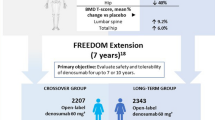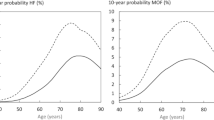Abstract
Objective
Postmenopausal women with breast cancer are at increased risk of bone loss because of age related estrogen deficiency face which accelerated with the use of aromatase inhibitors (AIs). We aimed to study the effect on bone mineral density (BMD) and bone formation biomarker osteocalcin level in postmenopausal breast cancer patients, for the first three years of adjuvant hormonal treatment of both groups Tamoxifen versus Anastrozol.
Methods
One-hundered postmenopausal breast cancers were prospectively randomized to receive either Tamoxifen 20 mg/day (n = 50) or Anastrozole 10 mg (n = 50). Both BMD and osteocalcin were assessed initially before treatment and then at regular intervals for both groups.
Results
Use of Tamoxifen was associated with significant annual decrease in osteocalcin (P = 0.001), whereas Anastrozole group had gradual increase of the annual levels (P < 0.01). BMD decreased significantly in Anastrozole versus Tamoxifen groups (2.6% vs. 0.4%, P < 0.001). Osteoporosis T < −2.5 was reported significantly higher in Anastrozole group (P < 0.01). Women with initial osteopenia in Anastrozole group showed significant decrease in BMD (P < 0.05). The addition of bisphosphonate for patients with early osteoporosis markedly improved both osteocalcin level and BMD.
Conclusion
Tamoxifen preserves BMD in postmenopausal breast cancer patients, whereas Anastrozole accelerates age associated fall in BMD especially in the first year of therapy, moreover, the addition of bisphosphonate can help to decrease the skeletal related events associated with treatment to ensure better quality of life with treatment.
Similar content being viewed by others
References
Geisler J, Haynes B, Anker G, et al. Influence of letrozole (Femara) and Anastrozole (Arimidex) on total body aromatization and plasma estrogen levels in postmenopausal breast cancer patients evaluated in a randomized, cross-over-designed study. J Clin Oncol, 2002, 20: 751–757.
Thurlimann B, Keshaviah A, Coates AS, et al. A comparison of Letrozole and Tamoxifen in postmenopausal women with early breast cancer. N Engl J Med, 2005, 353: 2747–2757.
Mouridsen H, Gershanovich M, Sun Y, et al. Phase III study of letrozole versus Tamoxifen as first-line therapy of advanced breast cancer in postmenopausal women: analysis of survival and update of efficacy from the international letrozole breast cancer group. J Clin Oncol, 2003, 21: 2101–2109.
Bischoff-Ferrari HA, Willett WC, Wong JB, et al. Fracture prevention with vitamin D supple-mentation: a meta-analysis of randomized controlled trials. JAMA, 2005, 293: 2257–2264.
Seeman E, Delmas PD. Bone quality: the material and structural bases of bone strength and fragility. N Engl J Med, 2006, 354: 2250–2261.
Osborne CK. Tamoxifen in the treatment of breast cancer. N Engl J Med, 1998, 339: 1609–1618.
Early Breast Cancer Trialists’ Group. Tamoxifen for early breast cancer: an overview of the randomized trials. Lancet, 1998, 351: 1451–1467.
Cella D, Fallowfield L, Barker P, et al. Quality of life of postmenopausal women in the ATAC (“Arimidex”, Tamoxifen, Alone or in Combination) trial after completion of 5 years’ adjuvant treatment for early breast cancer. Breast Cancer Res Treat, 2006, 100: 273–284.
Goss PE, Ingle JN, Martino S, et al. Randomized trial of Letrozole following Tamoxifen as extended adjuvant therapy in receptor-positive breast cancer: update findings from NCIC CTG MA.17. J Natl Cancer Inst, 2005, 97: 1262–1271.
Coombes RC, Kilburn LS, Snowdon CF, et al. Survival and safety exemestane versus Tamoxifen after 2–3 years’ Tamoxifen treatment (intergroup Exemestane Study): a randomized controlled trial. Lancet, 2007, 369: 559–570.
Rogers A, Hannon RA, Eastell R. Biochemical markers as predictors of rates of bone loss after menopause. J Bone Miner Res, 2000, 15: 1398–1404.
Ma CX, Adjei AA, Salavaggione OE, et al. Human aromatase: gene resequencing and functional genomics. Cancer Res, 2005, 65: 11071–11082.
Howell A, Cuxick J, Baum M, et al. Results of the ATAC (Arimidex, Tamoxifen, Alone or in Combination) trial after completion of 5 years’ adjuvant treatment for breast cancer. Lancet, 2005, 365: 60–62.
Winer EP, Hudis C, Burstein HJ, et al. American society of clinical oncology technology assessment on the use of aromatase inhibitors as adjuvant therapy for postmenopausal women with hormone receptor-positive breast cancer: status report. J Clin Oncol, 2005, 23: 619–629.
Lonning PE, Geisler J, Krag LE, et al. Effects of exemestane administered for 2 years versus placebo on bone mineral density, bone biomarker, and plasma lipids in patients with surgically resected early breast caner. J Clin Oncol, 2005, 23: 5126–5137.
Chein AJ, Goss PE. Aromatase inhibitors and bone health in women with breast cancer. J Clin Oncol, 2006, 24: 5305–5312.
Coleman RE. Effect of Anastrozole on bone mineral density: 5-year results from the Arimidex Tamoxifen Alone or in Combination (ATAC) trial. J Clin Oncol, 2006, 24: 5s.
Hillner BE, Ingle JN, Chlebowski RT, et al. American society of clinical oncology 2003 update on the role of bisphosphonates and bone health issues in women with breast cancer. J Clin Oncol, 2003, 21: 4042–4057.
Johnell O, Kanis J, Oden A. Predictive value of BMD for hip and other fractures. J Bone Min Res, 2005, 7: 1185–1194.
Brufsky AHW, Beck J. Zoledronic acid (ZA) effectively inhibits cancer treatment-induced bone loss (CITBL) in postmenopausal women (PMW) with early breast cancer (BCa) receiving adjuvant letrozole: 12 month BMD results of the Z-FAST trial. J Clin Oncol, 2005, 23: 12s.
World Health Organization. Assessment of fracture risk and application to screening for postmenopausal osteoporosis. Geneva, Switzerland, World Health Organization 1994.
Baum M, Budzar AU, Cuzick J, et al. ATAC Trialists’ Group: Anasatrozole alone or in combination with Tamoxifen versus Tamoxifen alone for adjuvant treatment of postmenopausal women with early breast cancer — first results of the ATAC randomized trial. Lancet, 2002, 359: 2131–2139.
Coombes RC, Hall E, Gibson LJ, et al. Intergroup Exemestane Study: a randomized trial of exemestane after two to three years of Tamoxifen therapy in postmenopausal women with primary breast cancer. N Engl J Med, 2004, 350: 1081–1092.
Geisler J, King N, Anker G, et al. In vivo inhibition of aromatizaton by exemestane, a novel irreversible aromatase inhibitor, in postmenopausal breast cancer patients. Clin Cancer Res, 1998, 4: 2089–2093.
Bonneterre J, Buzdar A, Nabholtz JM, et al. Anastrozole is superior to Tamoxifen as first-line therapy in hormone receptor positive advanced breast carcinoma. Cancer, 2001, 92: 2247–2258.
Goss PE, Ingle JN, Martino S, et al. A randomized trail of letrozole in postmenopausal women after five years of Tamoxifen therapy for early-stage breast cancer. N Engl J Med, 2003, 349: 1793–1802.
Jakesz R, Jonat W, Gnant M, et al. Switching of postmenopausal women with endocrine-responsive early breast cancer to Anastrozole after 2 years’ adjuvant Tamoxifen: combined results of ABCSG trial 8 and ARNO 95 trial. Lancet, 2005, 366: 455–462.
Perez EA, Josse RG, Pritchard KI, et al. Effect of letrozole versus placebo on bone mineral density in women with primary breast cancer completing 5 or more years of adjuvant Tamoxifen: a combination study to NCIC CTG MA.17. J Clin Oncol, 2006, 24: 3629–3635.
Eastell R, Adams JE, Coleman RE, et al. Effect of Anastrozole on bone mineral density: 5-year results from the Anastrozole, Tamoxifen, alone or in combination trial 18233230. J Clin Oncol, 2008, 26: 1051–1057.
Eastell R, Hannon RA, Cuzick J, et al. Effect or an aromatase inhibitor on BMD ad bone turnover markers: 2-year results of Anastrozole, Tamoxifen, alone or in combination (ATAC) trial. J Bone Miner Res, 2006, 21: 1215–1223.
Howell A, Forbes J, Cuzick J, et al. Initial adjuvant therapy with Anastrozole — early and late event data from the Arimidex, Tamoxifen, Alone or in Combination (ATAC) trial in the hormone-responsive population. St Gallen, 2009 Poster.
ATAC Trialists’ Group. Effect of Anastrozole and Tamoxifen as adjuvant treatment for early-stage breast cancer: 100-month analysis of the ATAC trial. Lancet Oncol, 2008, 9: 45–53.
Brown JP, Josse RG. Clinical practice guidelines for the diagnosis and management of osteoporosis in Canada. CMAJ, 2002, 167: s1–s34.
Mincey BA, Duh MS, Thomas SK, et al. Risk of cancer treatment-associated bone loss and fractures among women with breast cancer receiving aromatase inhibitors. J Clin Oncol, 2006, 24: 17s.
Kanis J, Brogsterom F, De Laet C, et al. Assessment of fracture risk. Osteoporos Int, 2005, 16: 581–589.
Author information
Authors and Affiliations
Corresponding author
Rights and permissions
About this article
Cite this article
Ezz Elarab, L.R., Swellam, M., Abdel Wahab, M.M. et al. Skeletal events of Anastrozole versus Tamoxifen on bone mineral density and bone biomarker osteocalcin in postmenopausal women with early breast cancer. Chin. -Ger. J. Clin. Oncol. 9, 574–578 (2010). https://doi.org/10.1007/s10330-010-0676-4
Received:
Revised:
Accepted:
Published:
Issue Date:
DOI: https://doi.org/10.1007/s10330-010-0676-4




